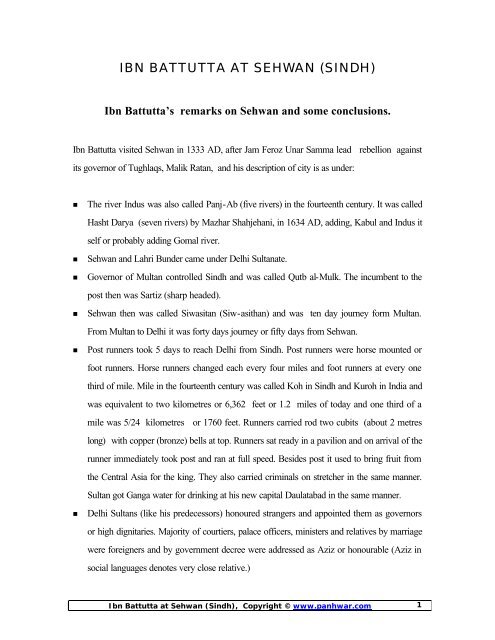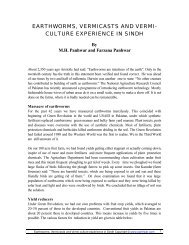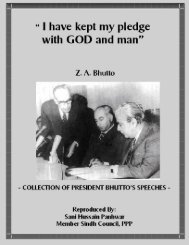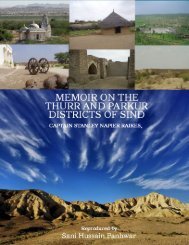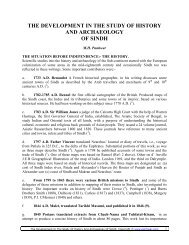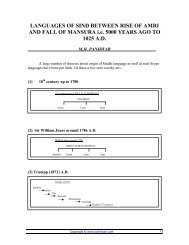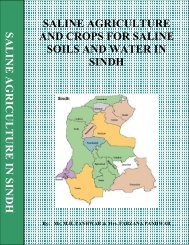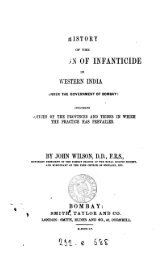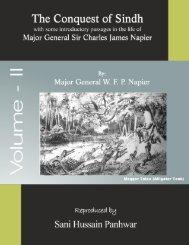IBN BATTUTTA AT SEHWAN (SINDH) - MH Panhwar
IBN BATTUTTA AT SEHWAN (SINDH) - MH Panhwar
IBN BATTUTTA AT SEHWAN (SINDH) - MH Panhwar
You also want an ePaper? Increase the reach of your titles
YUMPU automatically turns print PDFs into web optimized ePapers that Google loves.
<strong>IBN</strong> <strong>B<strong>AT</strong>TUTTA</strong> <strong>AT</strong> <strong>SEHWAN</strong> (<strong>SINDH</strong>)<br />
Ibn Battutta’s remarks on Sehwan and some conclusions.<br />
Ibn Battutta visited Sehwan in 1333 AD, after Jam Feroz Unar Samma lead rebellion against<br />
its governor of Tughlaqs, Malik Ratan, and his description of city is as under:<br />
The river Indus was also called Panj-Ab (five rivers) in the fourteenth century. It was called<br />
Hasht Darya (seven rivers) by Mazhar Shahjehani, in 1634 AD, adding, Kabul and Indus it<br />
self or probably adding Gomal river.<br />
Sehwan and Lahri Bunder came under Delhi Sultanate.<br />
Governor of Multan controlled Sindh and was called Qutb al-Mulk. The incumbent to the<br />
post then was Sartiz (sharp headed).<br />
Sehwan then was called Siwasitan (Siw-asithan) and was ten day journey form Multan.<br />
From Multan to Delhi it was forty days journey or fifty days from Sehwan.<br />
Post runners took 5 days to reach Delhi from Sindh. Post runners were horse mounted or<br />
foot runners. Horse runners changed each every four miles and foot runners at every one<br />
third of mile. Mile in the fourteenth century was called Koh in Sindh and Kuroh in India and<br />
was equivalent to two kilometres or 6,362 feet or 1.2 miles of today and one third of a<br />
mile was 5/24 kilometres or 1760 feet. Runners carried rod two cubits (about 2 metres<br />
long) with copper (bronze) bells at top. Runners sat ready in a pavilion and on arrival of the<br />
runner immediately took post and ran at full speed. Besides post it used to bring fruit from<br />
the Central Asia for the king. They also carried criminals on stretcher in the same manner.<br />
Sultan got Ganga water for drinking at his new capital Daulatabad in the same manner.<br />
Delhi Sultans (like his predecessors) honoured strangers and appointed them as governors<br />
or high dignitaries. Majority of courtiers, palace officers, ministers and relatives by marriage<br />
were foreigners and by government decree were addressed as Aziz or honourable (Aziz in<br />
social languages denotes very close relative.)<br />
Ibn Battutta at Sehwan (Sindh), Copyright © www.panhwar.com<br />
1
To be acceptable to king, the foreign visitors had to present gifts to the king and in return<br />
he gave them gifts many times this. The businessmen gave loan to foreigners, provided them<br />
with costly gifts and foreigners returned the loan or gifts to businessmen, who made large<br />
profits this way. This was flourishing business and Ibn Battuta did make use of the same<br />
facility.<br />
He saw rhinoceros on the Indus entering and crossing it in a northern Sindh forests. It had a<br />
single horn between eyes. It was smaller than an elephant, but had head bigger than that of<br />
elephant.<br />
After crossing western branch of the Indus between Kandhkot and Thul and two days by<br />
boat or march along its embankment he reached Junnani a large fine town on the bank of<br />
the Western Branch (called Warah Course). It was inhabited by Soomras (In 1955, M.H.<br />
<strong>Panhwar</strong> discovered ruins of this settlement in Taluka Warah, Deh Junnani and Junnani<br />
Inspection Bungalow, constructed by Sindh Public Works Department in nineteenth<br />
century, before advert of automobile and this vast bungalow also had stables for horses. It is<br />
build on a high mound of ruins and appears 3-4 feet about surrounding land, which have<br />
risen by about 3-4 feet since AD.)<br />
Ibn Battutta thinks that Soomras established them-selves there at the time of Arab conquest.<br />
Ibn Battutta narrated that Bahauddin Zakariya’s ancestor was with Muhammad Ibn Qasim<br />
Qureshi conquerer of Sindh. (This is incorrect as Bahauddin Zakariya’s grand father actually<br />
came from Khurasan in Central Asia.<br />
From Junnani he travelled to Sehwan. (He does not mention if he travelled by road or by<br />
boat and whether he passed through Manchar Lake.}<br />
Sehwan was large town out side which, there is sandy desert. (Since the river Indus was a<br />
few miles east of Sehwan, and on south of it, there was hilly desert and cultivated area was<br />
to its north and north west, he calls surroundings a sandy desert.)<br />
The desert was treeless except for acacia tree (acacia nilotica is a thorny tree.)<br />
Food of people consisted of sorghum (Jawar) and mushunk peas (probably mung). Of<br />
Jawar they make bread.<br />
There is plenty of supply of fish (from Manchar Lake) and the Indus and buffalo milk.<br />
Ibn Battutta at Sehwan (Sindh), Copyright © www.panhwar.com<br />
2
People also eat a reptile resembling lizard but having no tail. It probably was Giloi. People<br />
dug sand and fetched it out, then slit its stomach, threw out contents, stuffed it with curcuma<br />
(turmeric) and cooked and ate it. He hated it and did not eat it.<br />
He entered Sehwan in hottest part of year and heat was so intense that his companions sat<br />
naked except a small piece of cloth around their loins and another piece of cloth soaked<br />
with water on their back and shoulders and as this would dry in short time, it had to be<br />
soaked constantly again and again during hot period of the day. (M.H. <strong>Panhwar</strong> had seen it<br />
being done in Dadu Talukas in early thirties by some people in his village, but by 1950<br />
extension of irrigation and cultivation increased humidity and it is no longer being done.)<br />
In Sehwan he met a preacher al Shaibani, who showed in a Sanad (order) issued by Khalif<br />
Omar Ibn al-Aziz Damascus (717-720 AD), appointing his ancestor a preacher of the<br />
town, which post was inherited by him upto to that time. (It is improbable that Khalif<br />
Omar Ibn Abd al-Aziz had issued such a Sanad 600 years earlier.)<br />
At Sehwan he also met Shaikh Muhammad al-Baghdadi, reportedly 140 years old, who<br />
lived in hospice built at tomb of pious Shaikh Usman Marandi and claimed to have seen<br />
death of Mustasin Billah the last Abbasid Khalif. Inspite of his old age he was able to walk<br />
on his own feet. (This statement makes it clear that Qalander Osman [Lal Shahbaz] was<br />
from Marand, a suburb or Tabriz and tomb existed on his grave and was not built by Feroz<br />
Shah Tughlaq who became Sultan eighteen years later and tomb was elaborate enough to<br />
have a hospice for other important persons. That this man was 140 years old and still able<br />
to walk on his own feet is as doubtful as is the age of Qalander him-self.)<br />
He narrates details of Wunar al-Samiri (probably Jam Unar Sama) and Qaisar al-Rumi,<br />
who both were in Sultan’s service and had command of 1800 horseman. There also was a<br />
Hindu accountant of Sultan named Ratan skilled in writing and calculations. Sultan made him<br />
chief of Sindh and governor of Sehwan and its dependencies, with all honours drums, flag<br />
and privileges, accorded to principal amirs. Unar and Qaiser resented about such superior<br />
rank bestowed on an infidel and treacherously killed him, by taking him to a dependent<br />
district and at night created tumult that a lion had entered the camp and in such choas had<br />
him killed. Then they returned to Sehwan seized 12 lacs (gold dinars?). One gold dinar is<br />
Ibn Battutta at Sehwan (Sindh), Copyright © www.panhwar.com<br />
3
worth 10 silver dinars and Indian dinar was worth two dinars of Maghrib. Then Unar<br />
entitled him-self as Malik Feroz. (This Unar later on became first King of Samma dynasty of<br />
Sindh under title Jam [Malik] Feroz Unar in 1351/52 AD.) They distributed money among<br />
the troops but Unar owing to remoteness form his tribe, became alarmed for his safety, so<br />
left to join his tribe. Remaining troops appointed Qaiser al Rumi as their chief. When news<br />
reached Imdad al-Mulk Sartiz at Multan he collected troops both by land and the river<br />
Indus and after forty days seize of Sehwan, Qaiser being hard pressed asked for peace at<br />
some terms, which were accepted, but when they surrendered, Sartiz broke his word<br />
seized their property and decided to execute them. He would strike off heads of some of<br />
them, cut others in half and flay other alive and fill their skin with straw and hang them on<br />
city wall every day. Greater part of wall was thus covered with skins fixed on crosses. He<br />
also collected heads of some of them in the middle of town, where they formed a mound of<br />
some size. Ibn Battutta was staying on the roof of a college (Madersah) near the fort and<br />
not able to stand the scene of horror, he went away, to stay at some other place. Very soon<br />
he left for Lahri Bunder, from where he went to Multan and Delhi via Bakhar (Rohri).<br />
Ibn Battutta at Sehwan (Sindh), Copyright © www.panhwar.com<br />
4


